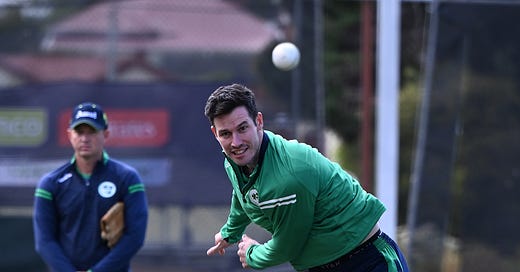Is George Dockrell now an ODI bowling specialist?
Weeks after being discarded as a T20 option, Dockrell impresses in longer format vs England
You’d be forgiven for being confused about George Dockrell’s role in this Irish side.
Not with the bat. As ever, his strengths there are undisputed. If anything, his effort of 43 off 54 balls in the 48-run defeat to England at Trent Bridge on Saturday was a departure from his normal modus operandi.
With England attacking with spin from both ends, Dockrell couldn’t launch into his usual array of powerful strokes off the seamers. Faced with Rehan Ahmed’s leg-spin and Tom Hartley’s slow left-armers, the Leinster Lightning captain instead had to grind out a more circumspect knock with none of the pace on the ball against which he thrives.
Not that he was completely prevented from taking Ahmed down the ground on occasion.
With the ball, questions around strategy remain. Last month, the word from the Ireland camp was that, because Dockrell and Curtis Campher bowled four overs for a combined 65 runs in the T20 World Cup qualifier final defeat to Scotland, they no longer trusted that pair to make up the fifth bowler’s quota. Instead, five frontline bowlers would be picked. The clear message: Campher and Dockrell are only to be used in an emergency. Neither bowled in the series vs India.
Today at Trent Bridge, Dockrell got eight overs under his belt, three more than McBrine, the only frontline spinner picked by Ireland. He earned his longer stint, taking three wickets at an economy of 5.37.
Dockrell was the sixth bowler used by Ireland, a break glass in case of emergency situation. 22 overs in, England were flying at 146-2, scoring at a hair under seven an over.
It could have been a thankless task given Ben Duckett, a left-hander who is generally an excellent player of spin, was motoring along. This was not Dockrell’s match-up to take on. Memories of the left-handed Ryan Burl scoring 29 runs of the six balls he faced from Dockrell during last winter’s tour of Zimbabwe should warn of the risk behind such a move.
“I know my stats against lefties wouldn’t be anywhere near as good as against a right-hander,” admitted Dockrell after Saturday’s defeat. “That’s the beauty of the sport, it wasn’t the match-up but I got the wicket.”
Duckett relinquished the advantage when he lap-swept a full delivery straight to Mark Adair at short fine. It was a huge bonus for Ireland. England’s best player of spin was gone and, with a series of right-handers to come, Dockrell could be a real threat as he built into his spell.
Except he wasn’t. Dockrell was taken off after just two overs, with figures of 1-9 at that stage. He returned eight overs later, bowling an expensive 30th which cost 13.
His response? The dismissal of Will Jacks who holed out deep on the leg side. Dockrell bowled four more overs after that on the trot, conceding another 20 runs and picking up the wicket of Jamie Smith. England’s debutant ‘keeper also picked out a fielder on the rope.
Dockrell’s spell gave Ireland what they so often lack in white ball cricket - wickets during the middle overs. Those scalps, along with good recoveries from the likes of Adair, went a long way to ensuring England didn’t get an embarrassing total, given they were looking likely to notch 400+ early on.
All of which once again poses the question of Dockrell’s bowling role in this side. Ireland’s selectors were clear when choosing to go down the five frontline bowlers route against India. Yet in the very next series, here he is forcing his way back into the reckoning.
It’s not the first time his tweakers have been called into question. After struggling on the springtime tour of the subcontinent, he returned to impressive form in the ‘home’ ODIs against Bangladesh in Chelmsford. Every time selectors suggest they want to move away from Dockrell, form elsewhere dictates he gets thrown the ball more in hope than anything else. Not for the first time, he came up trumps.
Confused? You should be. If you or I can’t figure out whether Dockrell is really a solid bowling option or not, it’s because Ireland can’t make up their mind either.
One theory could be that Ireland are happy to chop and change based on the format. This summer, Ireland have played 10 ODIs. Dockrell has bowled in nine of them, taking 13 wickets at an average of 25.
In recent T20Is? Dockrell has only bowled three times out of a possible seven. This summer, he took one wicket at an average of 36, economy of nine.
By contrast, Ireland’s other spinner on Saturday, Andy McBrine, has disappeared in T20s. In ODIs this summer, in the same 10 matches played as Dockrell, McBrine has taken seven wickets at an average of 48.57.
Despite bowling seven fewer ODI overs during that period, Dockrell has taken nearly double the wickets at almost half the average of Ireland’s premier off-spinner.
Considering England’s right-hand dominant lineup, McBrine’s lack of recent wickets and Ireland’s elongated tail with his inclusion in an ill-fitting power-hitting role, the argument to pick the leg-spinner and stronger batter Gareth Delany on Tuesday grows stronger.
As for Dockrell, small sample sizes are at play here, but a trend is emerging. He is a more economical and, more importantly when considering Ireland’s middle-overs deficiencies, a much more threatening bowler in ODI cricket.
Consciously or otherwise, Ireland have responded in kind. Finally, a clear strategy regarding the use of Dockrell’s bowling ability has started to emerge.
“It’s just the way it’s gone,” explained Dockrell of the accidental nature of the shift. “The nature of the game, I think with my skillset at the moment, ODI cricket through the middle maybe does suit me a little bit more than T20.
“As always, I’ll keep working on it, these things change quickly. It wasn’t that long ago I was bowling in the T20 World Cup and doing a job there.”







